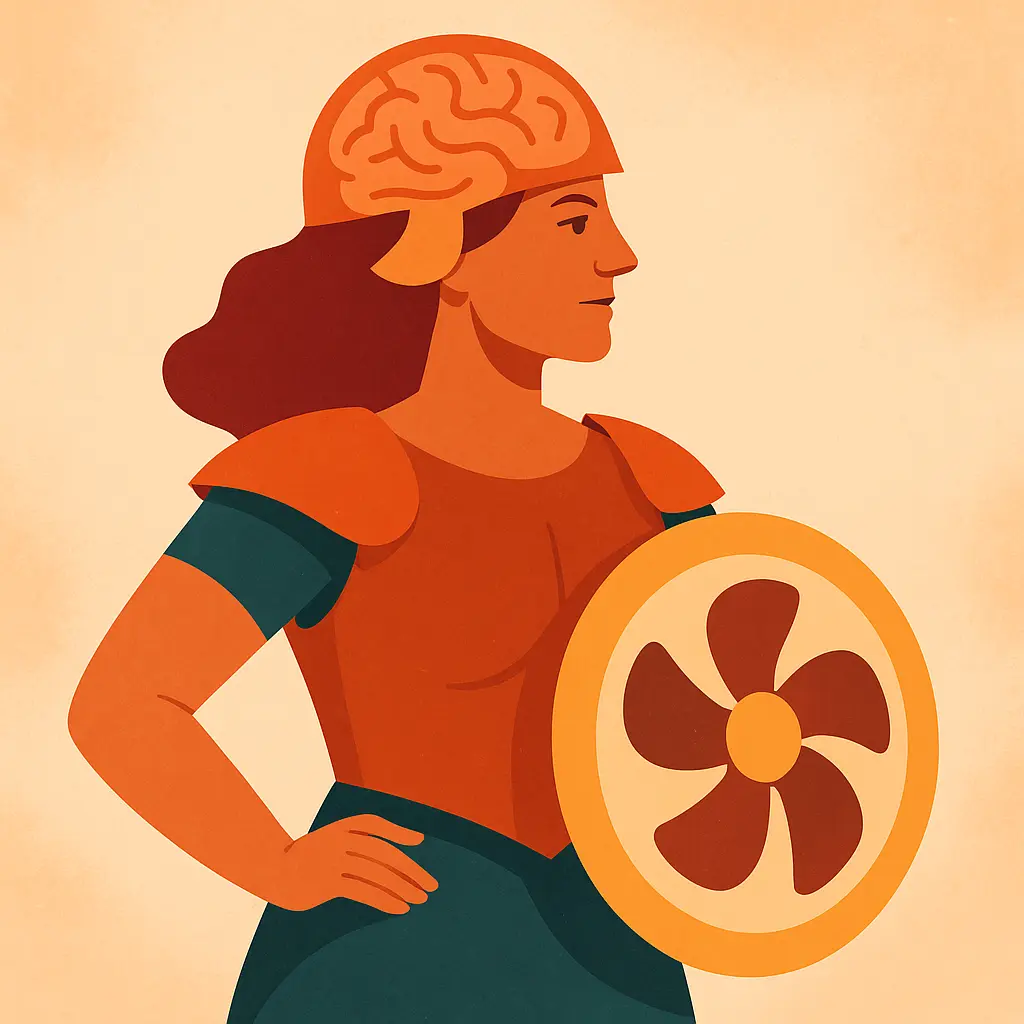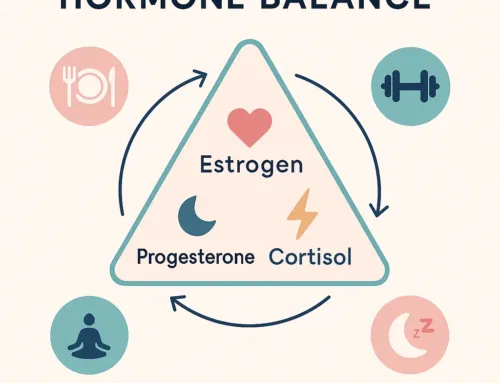
Approx. read time: 8.9 min.
Post: 10 Powerful Perimenopause Mindset Strategies for Menopause Armour & Natural Relief
perimenopause mindset strategies – Perimenopause and menopause mark profound transitions in a woman’s life. Fluctuating hormones can unleash a storm of hot flashes, sleep disturbances, mood swings and cognitive fog. At the same time, many women wrestle with negative self-talk—“I’m losing my edge,” “I feel out of control”—that only amplifies stress. But there’s a way to push back: think of yourself as gearing up for a battle, assembling both mental and physical armour to stand strong through these changes. This article lays out a clear, practical framework—a toolkit you can adapt—to fight off the “mindset demons” and combat the physical symptoms of midlife transitions. You’ll find both evidence-based treatments and lifestyle strategies, plus a sample weekly routine you can plug right into your calendar.
The Armour Metaphor
Imagine preparing for a challenge by donning protective gear and arming yourself with tools at your side. Your mindset armour shields you from self-defeating thoughts, anxiety and isolation. Your physical armour counters hot flashes, night sweats, bone loss and muscle tension. Wield them together and you’ll transform uncertainty into confidence, raging symptoms into manageable signals, and fear into action. The two layers integrate: stronger mental resilience helps you stick with exercise or medication; effective symptom control boosts mood and cognitive clarity.
Building Your Mindset Armour – perimenopause mindset strategies
- Psychoeducation
Knowledge is the first line of defence. Learning how estrogen, progesterone and other hormones interact with neurotransmitters can demystify mood swings and brain fog. When you realize that irritability or forgetfulness may be linked to a dip in estrogen, you stop blaming yourself and start seeking targeted solutions. - Cognitive Strategies
- Reframing: Catch negative self-talk in the act. If you think “My memory is fading,” consciously reframe it to “I’m adapting to a new hormonal balance; this momentary lapses won’t last.”
- Journaling: Spend five minutes each morning dumping your thoughts onto paper. This “mind dump” surfaces patterns—like stress triggers or racing thoughts—and frees up mental space for creative or problem-solving energy.
- Mind–Body Practices
- Mindfulness or Meditation: Even brief daily sessions (5–10 minutes) lower cortisol, calm racing thoughts and improve sleep quality. Apps or guided recordings can anchor you if silence feels daunting.
- Yoga or Tai Chi: Gentle movements synchronized with breath not only ease anxiety but also relieve joint stiffness and improve balance—critical as bone density naturally declines.
- Social Support
- Peer Groups: Finding an in-person or online menopause support group connects you with women facing similar challenges. Sharing practical tips—like cooling strategies or favorite supplements—normalizes the experience and supplies fresh ideas.
- Therapy or Coaching: A mental-health professional who understands midlife transitions can teach you coping skills, advanced cognitive-behavioral techniques and even body-based approaches like biofeedback.
- Self-Compassion Rituals
- Daily Wins Log: Before bed, jot down three successes, no matter how small: “I managed a cool-down before my hot flash,” or “I caught myself reframing negative thoughts.”
- Affirmation Reminders: Place sticky notes in visible spots—on the bathroom mirror, the refrigerator door—with short, positive affirmations like “I’ve got this” or “Change is growth.”
These tools form a mental shield. Over time, you’ll notice fewer panic spikes, faster emotional recovery after setbacks and a more grounded outlook.
Assembling Your Physical Armour – perimenopause mindset strategies
A. Medical & Supplement Treatments
- Hormone Replacement Therapy (HRT)
Widely regarded as the gold standard, HRT replaces declining estrogen (and often progesterone) to dramatically reduce hot flashes, night sweats and vaginal dryness. It can also stabilize mood swings and may protect bone density when started near menopause. Work with your doctor to choose the right formulation (pill, patch, gel) and dosage for your symptom profile and health history. - Non-Hormonal Prescription Options
- SSRIs/SNRIs (e.g., venlafaxine, paroxetine): Originally designed for depression, these medications can cut hot-flash frequency by up to 50%.
- Gabapentin or Clonidine: Off-label but clinically shown to ease night sweats, especially when SSRIs aren’t tolerated.
- Vaginal Estrogen
For women who prefer minimal systemic exposure, vaginal creams, rings or tablets deliver estrogen locally to relieve dryness, itching and discomfort during sex—without the dose that circulates through the rest of the body. - Supplements & Nutraceuticals
- Calcium + Vitamin D: Essential for maintaining bone strength as estrogen levels drop.
- Magnesium: Supports relaxation, improves sleep quality and helps prevent muscle cramps.
- Phytoestrogens (soy isoflavones, red clover): Plant-based compounds that mimic mild estrogenic activity; some women find they take the edge off hot flashes.
- Herbal Adaptogens (ashwagandha, Rhodiola): May boost energy, reduce stress and support adrenal function. Always start with a low dose and monitor how you feel.
B. Lifestyle Defenses
- Dietary Tweaks
- Protein + Fiber in Every Meal: Stabilize blood sugar to prevent mood crashes.
- Limit Caffeine & Alcohol: Both can trigger vasomotor symptoms and disrupt sleep.
- Hydration: Keep a water bottle handy. Sipping fluids can help your body regulate temperature through hot flashes.
- Exercise Routine
- Cardiovascular Exercise (30 minutes, 3–5× per week): Running, brisk walking, cycling or swimming can elevate mood, protect heart health and support healthy weight.
- Strength Training (2× per week): Lifting weights or body-weight workouts builds muscle, wards off age-related muscle loss and boosts metabolism.
- Pelvic-Floor Exercises: Daily Kegels strengthen the muscles that support bladder control and enhance sexual confidence.
- Sleep Hygiene
- Environment: Keep your bedroom around 18 °C, pitch-dark and quiet.
- Routine: Wind down with the same series of calming actions each night—herbal tea, light reading, gentle stretching—so your body learns to recognize “bedtime.”
- Screen Blackout: Ban screens at least one hour before sleep to avoid blue-light suppression of melatonin.
- Cool-Down Tactics
- Layering: Wear light, breathable layers to peel off at the first sign of a hot flash.
- Portable Fans & Chilled Pillow Packs: A small desk fan or a gel pack wrapped in a cloth can bring instant relief during sweats.
By combining medical treatments with lifestyle modifications, you create a multifaceted defence that attacks symptoms at their roots.
| Time | Mindset Armour | Physical Defence |
|---|---|---|
| 6:30 am | 5 min guided meditation + 3-item gratitude list | Glass of water + magnesium supplement + 10 min yin yoga |
| 7 am | Read sticky-note affirmation (“I adapt, I thrive”) | Protein-packed breakfast (egg, tofu or Greek yogurt) + phytoestrogens |
| 8 am | 1 min box-breathing before work tasks | Pelvic-floor exercises: 2 sets × 10 Kegels |
| 10:30 am | 2 min mindfulness pause—notice 3 sensory details | Cool herbal tea or water to sip during meeting |
| 12:30 pm | Record one “win so far” in your Wins Log | Balanced salad: greens, lean protein, whole grains |
| 3 pm | 5 min reframe session: swap a negative thought | Quick 5-10 min walk or stair climb to boost energy |
| 5:30pm | Brain-dump lingering worries in notebook | Exercise block: M/W/F strength circuit; T/Th cardio |
| 7 pm | Call or text a friend—share a laugh or thanks | Dinner: salmon or tempeh + roasted veggies; calcium + vitamin D |
| 8:30 pm | Gentle evening stretch or 5 min body scan | Cool-down kit: fan, neck pack by your bedside |
| 9:30 | 5 min guided sleep meditation | Herbal tea; no screens beyond this point |
| 10pm | Lights out | Room at ~18 °C, blackout curtains in place |
Weekend Boosters – perimenopause mindset strategies
Think of weekends as your reset button—a chance to reinforce your armour, recharge your energy, and set the tone for the week ahead. Small but intentional rituals on Saturdays and Sundays can amplify both mental and physical resilience.
Saturday Morning:
-
Join a group yoga class or virtual menopause meetup: Movement plus community is a double shield. Yoga or tai chi reduces cortisol, steadies mood, and helps bone and joint health, while the social connection normalizes your experience and fights isolation. Online menopause communities or local fitness groups provide both accountability and encouragement.
-
Meal-prep protein-packed snacks: Use part of your morning to batch-prep hormone-friendly snacks. Examples include high-protein chia pudding jars, almond butter muffins, or veggie-and-hummus cups. Having these ready prevents energy crashes and reduces reliance on caffeine or sugar, which can worsen hot flashes and mood swings.
Sunday Afternoon:
-
Nature walk or gentle hike with focused breathing: Stepping into nature has proven restorative effects—lower blood pressure, reduced anxiety, and improved sleep quality. Pairing movement with breath awareness (inhale for 4 steps, exhale for 6) grounds your nervous system and eases brain fog.
-
Plan your week with intention: Treat Sunday like your strategy session. Schedule workouts, plan balanced meals, and set a single mindset goal (e.g., “Notice my inner critic and reframe it,” or “Pause for 2 minutes of mindful breathing before stressful calls”). These small intentions compound into powerful resilience.
Putting It All Together – perimenopause mindset strategies
The armour metaphor works best when you layer it gradually. Don’t try to wear every piece at once—start with what feels most manageable.
-
Start Small: Pick one mindset tool (like journaling or daily affirmations) and one physical defence (like walking 20 minutes a day or adding magnesium at night). Master those before adding new ones.
-
Track Progress: Use a simple habit tracker—paper, journal, or a free app. Write down what you try, your symptoms, and how you feel. Over time, patterns emerge, showing which strategies give you the biggest return.
-
Monitor & Adjust: After two weeks, review your tracker. Let go of strategies that drain your energy or don’t provide results. Replace them with new tools from your armoury, such as adding strength training, mindfulness, or adjusting supplements. Flexibility is part of resilience.
-
Consult a Professional: Book quarterly check-ins with your GP, gynecologist, or menopause specialist. These visits help you evaluate bone density, cardiovascular health, and mental well-being. They’re also a safe space to discuss HRT adjustments, test results, or supplement fine-tuning. Having a professional partner ensures your armour evolves as your needs change.
Final Takeaway – perimenopause mindset strategies
Successfully navigating perimenopause and menopause isn’t about simply enduring the storm—it’s about thriving through it. Each tool you adopt, whether a mindset technique or a physical treatment, becomes another plate of armour that strengthens your ability to face change with confidence. With every weekend reset, every small routine, and every professional check-in, you build a shield that transforms chaos into calm.
By gearing up with this comprehensive toolkit—mental strategies that fortify your resolve and physical defences that tame symptoms—you reclaim control. The battle may be challenging, but your armour is strong. Each layer brings you closer to stability, self-assurance, and a lasting sense of well-being in this powerful new stage of life.









